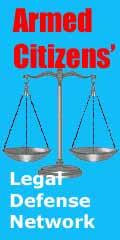|
|
||||||||
|
Search NNSD
In This Hub:
Donate to NNSD
Marc MacYoung?
Fiction
Some of the authors listed in the other column also write fiction. In many
ways it's easier to learn application of this information in that
context.
Non-fiction
|
Protect yourself ...
On this page: A basic rule of salesmanship is you market to the people who have the money. But, a raw truth is: Most people don't think about personal safety until they have a pressing need. This immediate need is usually combined with the lack of thousands of dollars to buy a high-tech security service, hire a lawyer or a bodyguard. The No Nonsense site will provide you free, easy-to-use information to keep you safe from violence and crime. Our goal is to give you common sense information you can use right now to ensure your personal safety and protect your property. We're not here to sell you our products or services. Any 'money making' from this site comes through donations and you buying recommended books/videos about subjects you want to know more about. (We're an Amazon Affiliate.) We Address a Wide
Spectrum of Needs Other parts are for those in self-defense training, whether martial arts or firearms. Our goal there is to fill in what your instructors aren't telling you about using your training. (Often because they don't know it themselves.) Still others parts of this site are for those who work in either violence professions or public contact jobs. With the former, using force is part of their job. We'll make you better. Then there's what we call "First Contact Jobs." With any public contact job confrontation and maybe even violence is an everyday possibility. This especially if your job often includes telling people "no," or you deal with a wide range of subcultures and economic classes. Putting it bluntly, violence is real, so too are the
consequences. We're going to help you avoid it if possible.
If that's not possible, we'll help you prepare to
handle both the violence and its aftermath.
The Cure Is NOT Worse Than The Problem Does it take decades of work to be safe? Do you have to spend thousands of dollars? Do you need to become a martial arts master to defend yourself? Do you need to become a paranoid survivalist in order to be safe? Do you need to buy a stock pile of guns? No. Are you going to have to learn some things to use common sense? Yes. And that isn't that hard. But in order to have common sense in the first place, you must understand what's actually involved in the problem. Not what you think you know about violence from watching movies and the news. We'll tell you right now that the hardest part about learning this subject is unlearning dangerous misconceptions you've been told. This includes some deliberate lies by people trying to make a buck off you. For example that having a black belt means you can 'take care of yourself' or having a gun means you're safe. By themselves, neither of those are 'self-defense,' nor will they help you with your goal of personal safety. On the other hand, once you have solid information, then making the right decisions for a situation is easy. We take what we call the 'low impact approach' to
personal safety. The object of this exercise is to improve
the quality of you life, not degrade it. With this in mind,
we suggest you read
What Do I Have To Do To Be Safe? to get an idea of
what you don't have to do to achieve personal safety.
No Push Button Answers The parts that make up conflict –and even violence– are rather simple. You could learn the basics in a day. That's not where the challenge is. It's how these elements combine in different situations that is the tricky part. (Not the hard part, we'll get to that in a bit.) This ties back to "there are no, 'you just do this' fixes" What is the right response in one situation is a disaster in others. Whether that is because it's insufficient or excessive depends on the circumstances of those situations; just as what made that level "right" in the original situation were the circumstances. For example there are many situations where lethal force is completely unwarranted and others–far fewer– where any lesser force will fail catastrophically. Still there are many more where a sincere apology and walking away resolves the whole thing. Unfortunately, which is which is rather non-negotiable, so proper identification is important. Being able to recognize which kind of situation you're in requires knowledge and understanding. Being able to do-it-on-the-spot when you're in danger takes practice. But even though it's not complex, it's not necessarily easy. But from a direction most people in self-defense training never consider. The price of making the right choice in a situation is skullsweat and self-honesty. What do we mean by the last? If you're in a situation, it took you time to get there. It's going to take time and effort to get out -- including changing behaviors that helped create the situation. That's a hard pill to swallow. But there it is. Statement of fact: Violence doesn't occur in a vacuum. Nor does it 'just happen' or 'come out of nowhere.' The lead up to violence (and even crime) is a study in the choices, behaviors and communication between ALL the people involved. That means -- contrary to what you might think -- you have a lot more power and control over what happens. Unfortunately, this is a two edged sword. Yes, you can prevent most violence with your words and actions, but you can also provoke it. (That's why we spend a lot of time on people skills, communication and controlling your emotions on this site.) While we like to think of ourselves as the 'good guy' in a situation (or the aggrieved party) ...well, putting it politely ... there's usually another interpretation of our behavior. In fact, let's look at one of the most common mistakes people make. That's threatening someone when we're scared. You're saying those things to get him to back off, but those also qualify as provoking and participating. Knowledge is knowing certain behaviors provoke. Self-honesty is first recognizing and then admitting that you did them. The hard part (remember we said we'd come back to this) is developing the self-control not to do them when you're emotional and adrenalized. This is do-able, but it takes practice before you find yourself in a situation where a lack of self-control will put you into the hospital, prison or the cemetery. Understand in these days of cell phone and security video, the odds are good you will be filmed. The District Attorney will try to use that video to convict you. You may have been defending yourself, but that video of you howling, barking and threatening the guy makes it look like you were fighting – and you beat him up. Here's another common mistake people make. That is thinking that 'what they meant to do' with an action is the only possible outcome. For example, NYC's Nicole DuFrense. Her last words to a mugger and his pack were, "You got what you wanted! Why don't you leave? What are you going to do now? Shoot us?" Well, now that you mentioned it. Comfortably sitting and reading this, her saying that
seems the height of stupidity.
However, we can understand her words if we consider
three points In that light, through attitude and words alone she was trying to end the situation and ensure her friends and hers' safety. How do you normally chase away someone you don't like? By showing attitude and challenging them. That approach is especially common among city dwellers; often to the point of reflex. Except, these were not 'normal' circumstances. Her default conflict behavior got her killed facing a mugger– because a mugging is not a conflict. It's a violent crime. Now in case you're thinking you're too smart to do that, I'll bet you dollars to doughnuts Ms DuFresne thought so too. Something you need to know. There's part of your brain that will be screaming at you to be the most provoking, insulting and hurtful you can be to the other person. This is especially true when you're afraid or angry. (Two of the most common emotions around violence.) While that behavior often works in situations where physical violence is off the table, it provokes someone who is physically violent. Sound complicated? Well it is. As a therapist friend of mine is fond of saying "Humans are messy." We are complex multi-layered, inconsistent, hypocritical, self-justifying, often contradictory, emotional creatures. That really applies to violence - - especially when it comes our own. Violence is very much a human behavior (we're biological animals after all.) A lot of what we're conditioned to believe about violence denies this, as well as our own 'wiring.' That often leaves you trapped between your biology and social conditioning and the law. We're here to help you get out of that trap. At the same time, the very fact that you're human, is really going to help you understand and navigate these complexities. You do this kind of stuff all the time, we're just going to make you more aware of what you already know about people. Like I said, common sense. If you've ever taken any self-defense training was any of this mentioned? We'll tell you right now: Self-defense is much more
than just physical. It's all that other stuff -- stuff
you won't get from just physical training -- that we cover
here. So like we said, even though the information is free,
the price you're going to have to pay is skullsweat and
time. If you know what you want to learn, go ahead and skip
there. If not, keep reading.
Why Is Crime Simpler Than Interpersonal Violence? When you think about it, this makes sense. Those around you are the ones you're most likely to come in conflict with. When was the last time you had an argument with a total stranger vs. when did you last have an argument with someone you knew? This is what makes dealing with interpersonal violence more complicated than just avoiding a crime. Interpersonal violence IS personal. Quite frankly, an outright crime is much easier to avoid. In fact, if you know what to look for, crime is really easy to prevent. He's not coming after you personally. Since robbing you is just as easy as robbing someone else, the criminal doesn't care who he selects. The easier the target the better. It is with interpersonal violence that things become complex. That's because criminal violence has a recognizable and external goal. Interpersonal violence is filled with all kinds of internal and subjective standards, goals and emotions. Usually what you are protecting, trying to achieve or fighting over in such conflicts, ISN'T physical. And yet, conflicts can -- and often do -- escalate into physical violence. Such violence IS usually 'personal.' Not only from the standpoint of it IS directed at a particular person, but that it is often a form of punishment. That person is seeking physical revenge for the emotional hurt you caused him or her. With this in mind, realize: What you say and do has a HUGE effect on whether or not you are physically assaulted. You do have power and control over whether or not you are attacked. Teaching you how to exercise this power is what this site is mostly about. Where things get really complicated is that there is NO ONE simplistic strategy that you can use in every situation. What works to resolve a conflict with one person will provoke another into attacking. You may think what you're doing will scare him away, but often you're actually pouring gasoline onto the fire. Knowing when to do what and when NOT to do that are another reason why things get complicated. Personal safety is less about punching and kicking and more about people skills. Large sections of this site are dedicated to looking at the nature of conflict, including the difference between assertiveness and aggression, how we behave under stress, the psychology of conflict, why violence occurs and how not to provoke a physical assault. These are all elements that will cause a conflict to escalate to physical violence. What you say and do has a major influence on finding yourself involved in violence. This fact does not magically disappear because you are upset, angry or arguing. When you are emotionally caught up in a conflict, it is easy to not only provoke an attack from someone else, but it is appalling easy for you initiate the physical violence. As unbelievable as it may sound, you can do this without even realizing you did it until the person counter attacks. Even easier is to say something so hurtful and insulting that the person flies into a rage and attacks. Over 2,000 years ago Horace wrote "Anger is a short madness (insanity)." You can be so angry, emotional or upset that you don't realize what you are doing. But that doesn't mean you aren't doing it. Realize this is a two-way street, the same thing can be happening with the person you are in conflict with. But in fact, violent people are violent because they lack the self-control NOT to act on these impulses. This lack can be circumstantial, physiological, psychological or simply because the person chooses to behave this way. While anyone can be pushed too far, some people believe violence is a fast and easy way to get what they want. Because so much violence arises from conflict, it seriously complicates the subject of self-defense. If you participated in the creation, escalation and mutual physicality of the situation, that really isn't self-defense. Most people call it fighting. In case you didn't know it, while self-defense is legal, fighting isn't. You should also know this is why so many people are supposedly arrested for' self-defense.' "Go to prison for defending myself" is a common wail. The truth is, most the time the weren't defending themselves, they were actually fighting. But when you are emotional, angry or scared, everything you do seems like self-defense. That big bad person was attacking you! While that is your perception, that isn't necessarily what was happening. Nor is is necessarily what you were doing. Your brain under extreme emotion and stress sees things differently than when you are calm. And those perceptions can lead you to chasing someone down the street slashing them with a knife thinking what you are doing is self-defense. It isn't. It is their inability to tell the difference -- not unjust laws -- that gets most people into trouble. And in more ways than one. It's also what causes a situation to go from verbal violence to physical violence. This is also why we give a layman's explanation of what self-defense is and when what you're doing stops being self-defense. Believe it or not, personal safety is less about what you do than it is about what you don't do -- especially in certain situations. The 'why you don't do that' is what makes both the subject of violence -- and this site -- so big and complex. Once you understand 'why certain behaviors will lead to violence' you greatly lessen your chances of unwittingly doing them. Not only will this keep you from being arrested for fighting or assault, but it greatly reduces your chances of being raped, assaulted, beaten or even killed. There are no simple answers when it comes to interpersonal violence. That is because YOU are a major factor in whether it happens or not. Your choices, your behaviors and what you say, have major influence on whether or not physical violence occurs. So you DO have control over whether violence happens to you -- or not. But it starts with you controlling your emotions, instead of your emotions controlling you. The reason this is important is that the person who resorts to physical violence the fastest is almost always being driven there by HIS out of control emotions. If you aren't willing to go faster and further down that road than he is, then you will lose that race. Oh, by the way. This information
will also go miles for improving the quality of your
life, lessening conflict in your life and help you get
along with other people. This site isn't just about
self-defense, it's also about developing every day
people skills to make your life easier.
New Pages Following that Home Invasion. Whether it's a robbery, break in rapist, serial killer or you surprised a burglar, strangers in your home are not good. The next newest page is Disneyland State Of Mind/Hermit Crabs. It's a look at how an entitled mindset create a nightmare attitude well known to violence professionals, but at the same time very dangerous to average people, especially teens and young adults. Drunk, self-righteous, reckless and an eyeblink away from fury those in the DSOM cause all kinds of trouble. After that is "
Don't Make It So Your Children Are Afraid To
Call You For Help." Teens do the dumb. It's
a fact of life. However, often small solvable
problems are compounded into life altering
crisis's by stacking more and more bad
decisions. Decisions made because the teen is
afraid of you getting angry. Want to know how to tell you're about to be attacked?Here we look at the biggest Pre-Attack Indicator of them all. What are the behaviors that lead to violence? In this Martial Secrets podcast, Kris Wilder interviews Marc MacYoung about Conflict Communications and why violence happens The HUGE difference between Fear Management and Danger Management. The difference is one actually keeps you safe. The other not only puts you in more danger, but makes you feel better about it.
|
|
||||||
|
||||||||








